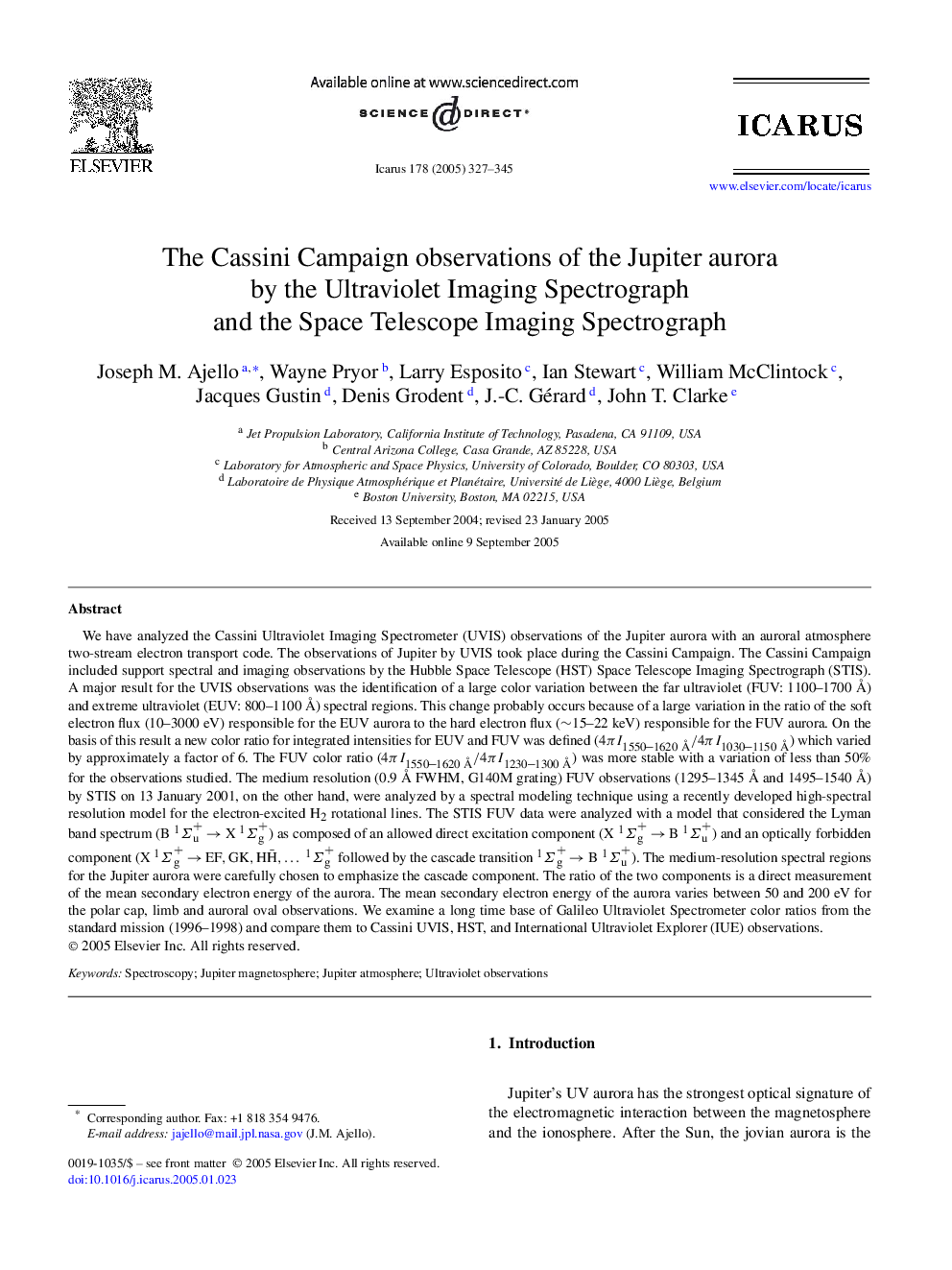| کد مقاله | کد نشریه | سال انتشار | مقاله انگلیسی | نسخه تمام متن |
|---|---|---|---|---|
| 10701830 | 1021219 | 2005 | 19 صفحه PDF | دانلود رایگان |
عنوان انگلیسی مقاله ISI
The Cassini Campaign observations of the Jupiter aurora by the Ultraviolet Imaging Spectrograph and the Space Telescope Imaging Spectrograph
دانلود مقاله + سفارش ترجمه
دانلود مقاله ISI انگلیسی
رایگان برای ایرانیان
کلمات کلیدی
موضوعات مرتبط
مهندسی و علوم پایه
علوم زمین و سیارات
علوم فضا و نجوم
پیش نمایش صفحه اول مقاله

چکیده انگلیسی
We have analyzed the Cassini Ultraviolet Imaging Spectrometer (UVIS) observations of the Jupiter aurora with an auroral atmosphere two-stream electron transport code. The observations of Jupiter by UVIS took place during the Cassini Campaign. The Cassini Campaign included support spectral and imaging observations by the Hubble Space Telescope (HST) Space Telescope Imaging Spectrograph (STIS). A major result for the UVIS observations was the identification of a large color variation between the far ultraviolet (FUV: 1100-1700 Ã
) and extreme ultraviolet (EUV: 800-1100 Ã
) spectral regions. This change probably occurs because of a large variation in the ratio of the soft electron flux (10-3000 eV) responsible for the EUV aurora to the hard electron flux (â¼15-22 keV) responsible for the FUV aurora. On the basis of this result a new color ratio for integrated intensities for EUV and FUV was defined (4ÏI1550-1620Ã
/4ÏI1030-1150Ã
) which varied by approximately a factor of 6. The FUV color ratio (4ÏI1550-1620Ã
/4ÏI1230-1300Ã
) was more stable with a variation of less than 50% for the observations studied. The medium resolution (0.9 Ã
FWHM, G140M grating) FUV observations (1295-1345 Ã
and 1495-1540 Ã
) by STIS on 13 January 2001, on the other hand, were analyzed by a spectral modeling technique using a recently developed high-spectral resolution model for the electron-excited H2 rotational lines. The STIS FUV data were analyzed with a model that considered the Lyman band spectrum (B Σu+1âXΣg+1) as composed of an allowed direct excitation component (X Σg+1âBΣu+1) and an optically forbidden component (X Σg+1âEF,GK,HH¯,â¦Î£g+1 followed by the cascade transition Σg+1âBΣu+1). The medium-resolution spectral regions for the Jupiter aurora were carefully chosen to emphasize the cascade component. The ratio of the two components is a direct measurement of the mean secondary electron energy of the aurora. The mean secondary electron energy of the aurora varies between 50 and 200 eV for the polar cap, limb and auroral oval observations. We examine a long time base of Galileo Ultraviolet Spectrometer color ratios from the standard mission (1996-1998) and compare them to Cassini UVIS, HST, and International Ultraviolet Explorer (IUE) observations.
ناشر
Database: Elsevier - ScienceDirect (ساینس دایرکت)
Journal: Icarus - Volume 178, Issue 2, 15 November 2005, Pages 327-345
Journal: Icarus - Volume 178, Issue 2, 15 November 2005, Pages 327-345
نویسندگان
Joseph M. Ajello, Wayne Pryor, Larry Esposito, Ian Stewart, William McClintock, Jacques Gustin, Denis Grodent, J.-C. Gérard, John T. Clarke,